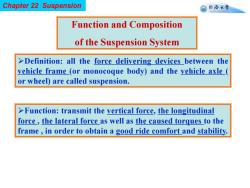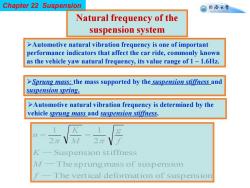同济大学:《汽车构造》课程电子教案(课件讲稿)Chapter 22 悬架 Suspension

Chapter 22 Suspension 同©大学 TONGII UNIVERSTTY Chapter 22.Suspension
Chapter 22 Suspension Chapter 22. Suspension

Chapter 22 Suspension 窗月桥大学 TONGII UNIVERSTTY Content The composition,function and elassification ofsuspension: >Structure form of common springs: >Structure form of common dampers; >rigid axle suspension >independent suspension >balanced suspension of multi-axle yehicle: active suspension and semi-active suspension
Chapter 22 Suspension Content The composition, function and classification of suspension; Structure form of common springs; Structure form of common dampers; rigid axle suspension ; independent suspension ; balanced suspension of multi-axle vehicle; active suspension and semi-active suspension

Chapter 22 Suspension 圖月儕大学 TONGII UNIVERSTTY Section 1.Overview 的 Audi O5
Chapter 22 Suspension Section 1. Overview

Chapter 22 Suspension 窗月桥大学 TONGII UNIVERSITY Function and Composition of the Suspension System >Definition:all the force delivering devices_between the vehicle frame_(or monocoque body)and the yehicle axle_( or wheel)are called suspension. >Function:transmit the vertical force,the longitudinal force the lateral force as well as the caused torques to the frame,in order to obtain a good ride comfort and stability
Chapter 22 Suspension Function: transmit the vertical force, the longitudinal force , the lateral force as well as the caused torques to the frame , in order to obtain a good ride comfort and stability. Function and Composition of the Suspension System Definition: all the force delivering devices between the vehicle frame (or monocoque body) and the vehicle axle ( or wheel) are called suspension

Chapter 22 Suspension 同©大学 TONGII UNIVERSTTY Function and Composition of the Suspension System Lateral rod/Panhard rod Stabilizer bar Dampers Suspension Springs Longitudinal rod >Main components:spring elements,dampers(shock absorber),guide mechanism (longitudinal rod,lateral rod).Some vehicles also equipped with the stabilizer bar
Chapter 22 Suspension Suspension Springs Dampers Stabilizer bar Longitudinal rod Lateral rod/ Panhard rod Function and Composition of the Suspension System Main components: spring elements, dampers(shock absorber), guide mechanism (longitudinal rod, lateral rod). Some vehicles also equipped with the stabilizer bar

Chapter 22 Suspension 同©大学 TONGII UNIVERSTTY Function of each components in suspension system >Spring elements:to make the connection of the frame and axle having elasticity and the ability of absorbing,buffering road impact and vibration. >Damping elements:attenuate of the vibration of the spring elements,absorb and dissipate vibrational energy. Guide arm:holding wheel trajectory,carrying and transmit > forces and torques. >Stabilizer(anti-roll bar):by steering condition,reducing body inclination and lateral angular vibration
Chapter 22 Suspension Function of each components in suspension system Spring elements: to make the connection of the frame and axle having elasticity and the ability of absorbing, buffering road impact and vibration. Damping elements: attenuate of the vibration of the spring elements, absorb and dissipate vibrational energy. Guide arm: holding wheel trajectory, carrying and transmit forces and torques. Stabilizer(anti-roll bar): by steering condition, reducing body inclination and lateral angular vibration

Chapter 22 Suspension 同©大学 TONGII UNIVERSTTY Natural frequency of the suspension system >Automotive natural vibration frequency is one of important performance indicators that affect the car ride,commonly known as the vehicle yaw natural frequency,its value range of 1~1.6Hz. >Sprung mass:the mass supported by the suspension stiffness and suspension spring. >Automotive natural vibration frequency is determined by the vehicle sprung mass and suspension stiffness. K-Suspension stiffness M-The sprung mass of suspension The vertical deformation of suspension
Chapter 22 Suspension Natural frequency of the suspension system The vertical deformation of suspension The sprungmass of suspension Suspension stiffness 2 1 2 1 — — — f M K f g M K n Automotive natural vibration frequency is one of important performance indicators that affect the car ride, commonly known as the vehicle yaw natural frequency, its value range of 1 ~ 1.6Hz. Sprung mass: the mass supported by the suspension stiffness and suspension spring. Automotive natural vibration frequency is determined by the vehicle sprung mass and suspension stiffness

Chapter 22 Suspension 蜀同儕大学 TONGII UNIVERSITY Natural vibration frequency of suspension system 2元V Suspension stiffness The sprung mass of suspension The vertical deformation of suspension >Definitely sprung mass,the smaller the suspension stiffness,the smaller the yaw natural frequency,but with a larger wheel up and down. >Definitely suspension stiffness,the greater the sprung mass,the smaller the yaw natural frequency. >Because of the changing vehicle load,the suspension spring needs to be with variable stiffness characteristics,to ensure that the vehicle ride comfort quite different load cases
Chapter 22 Suspension Natural vibration frequency of suspension system — The vertical deformation of suspension — The sprung mass of suspension — Suspension stiffness 2 1 2 1 f M K f g M K n Definitely sprung mass, the smaller the suspension stiffness, the smaller the yaw natural frequency, but with a larger wheel up and down. Definitely suspension stiffness, the greater the sprung mass, the smaller the yaw natural frequency. Because of the changing vehicle load, the suspension spring needs to be with variable stiffness characteristics, to ensure that the vehicle ride comfort quite different load cases

Chapter 22 Suspension 同©大学 TONGII UNIVERSTTY The type of suspension system >Suspension systems can be broadly classified into two subgroups:rigid axle suspensions and independent suspensions referring to the ability of opposite wheels to move independently of each other. 车身 车轮统动 停止 车轮扶动 停止 非独立悬架 独立悬架 >Characteristics:two wheels on both >Characteristics:the axle is disconnected. sides are connected with a rigid axle,the two wheels on both sides connected to the rigid axle connected to the frame or body frame (or body)individually through the through the suspension.The motion of suspension.Each side of the wheel can one wheel affects the motion of the other be move independently wheel during single-wheel compression events
Chapter 22 Suspension The type of suspension system Suspension systems can be broadly classified into two subgroups: rigid axle suspensions and independent suspensions referring to the ability of opposite wheels to move independently of each other. Characteristics: two wheels on both sides are connected with a rigid axle, the rigid axle connected to the frame or body through the suspension. The motion of one wheel affects the motion of the other wheel during single-wheel compression events. Characteristics: the axle is disconnected, two wheels on both sides connected to the frame (or body) individually through the suspension . Each side of the wheel can be move independently

Chapter 22 Suspension 日©大学 TONGII UNIVERSTTY The Types of Suspension System >According to the suspension >The suspension stiffness, controlled or suspension damping in motion can not not be adjusted. >Passive >Suspension stiffness,damping suspension can be adjusted automatically according to the traveling >Active condition. suspensions >Only a suspension damping of >Semi-active the suspension can be adjusted suspensions automatically
Chapter 22 Suspension According to the suspension controlled or not Passive suspension Active suspensions Semi-active suspensions The Types of Suspension System The suspension stiffness, suspension damping in motion can not be adjusted . Suspension stiffness , damping can be adjusted automatically according to the traveling condition. Only a suspension damping of the suspension can be adjusted automatically
按次数下载不扣除下载券;
注册用户24小时内重复下载只扣除一次;
顺序:VIP每日次数-->可用次数-->下载券;
- 同济大学:《汽车构造》课程电子教案(课件讲稿)Chapter 21 车轴和车轮 Axle and Wheel.pdf
- 同济大学:《汽车构造》课程电子教案(课件讲稿)Chapter 20 车架和车身 Frame and Monocoque Body.pdf
- 同济大学:《汽车构造》课程电子教案(课件讲稿)Chapter 19 传动装置 Running Gear.pdf
- 同济大学:《汽车构造》课程电子教案(课件讲稿)Chapter 18 驱动桥 Driving Axle.pdf
- 同济大学:《汽车构造》课程电子教案(课件讲稿)Chapter 17 传动装置 Universal Gearing.pdf
- 同济大学:《汽车构造》课程电子教案(课件讲稿)Chapter 16 自动变速器 Vehicle Automatic transmission.pdf
- 同济大学:《汽车构造》课程电子教案(课件讲稿)Chapter 15 变速箱 Transmission and transfer case.pdf
- 同济大学:《汽车构造》课程电子教案(课件讲稿)Chapter 14 离合器 Clutch.pdf
- 同济大学:《汽车构造》课程电子教案(课件讲稿)Chapter 13 传动系统 Overview of automobile drivetrain.pdf
- 同济大学:《汽车构造》课程电子教案(课件讲稿)Automobile structure(Types of modern automobiles).pdf
- 同济大学:《汽车构造》课程电子教案(课件讲稿)第十二章 发动机有害排放物的控制系统 Control System of Harmful Emissions in Engine Exhaust.pdf
- 同济大学:《汽车构造》课程电子教案(课件讲稿)第十章 发动机点火系统 Engine Ignition System.pdf
- 同济大学:《汽车构造》课程电子教案(课件讲稿)第八章 发动机润滑系 Lubrication System for Automotive Engines.pdf
- 同济大学:《汽车构造》课程电子教案(课件讲稿)第九章 起动系统 Starting System.pdf
- 同济大学:《汽车构造》课程电子教案(课件讲稿)第七章 发动机冷却系 Cooling System.pdf
- 同济大学:《汽车构造》课程电子教案(课件讲稿)第五章 柴油机燃油供给系统 Fuel Supply System for Diesel Engines.pdf
- 同济大学:《汽车构造》课程电子教案(课件讲稿)第六章 进气、排气及增压系统 Intake, Exhaust and Boost Systems.pdf
- 同济大学:《汽车构造》课程电子教案(课件讲稿)第四章 汽油机燃油供给系统 Fuel Supply System For Gasoline Engine.pdf
- 同济大学:《汽车构造》课程电子教案(课件讲稿)第三章 配气机构 Valve Trains(负责人:李理光).pdf
- 同济大学:《汽车构造》课程电子教案(课件讲稿)第二章 机体组及曲柄连杆机构 Engine Block, Crank and Connecting Rod Mechanism.pdf
- 同济大学:《汽车构造》课程电子教案(课件讲稿)Chapter 23 汽车转向系统 Steering system.pdf
- 同济大学:《汽车构造》课程电子教案(课件讲稿)Chapter 24 制动系统 Braking system.pdf
- 同济大学:《汽车构造》课程电子教案(课件讲稿)Chapter 25 车身 Car body.pdf
- 同济大学:《汽车构造》课程电子教案(课件讲稿)Hydro-mechanical Transmission and Continuously Variable Transmission.pdf
- 四川大学:制造科学与工程学院《工程测试技术与信息处理》本科课程教学大纲 Engineering Measurement and Signal Analysis.pdf
- 东华大学:《画法几何与工程制图》课程教学资源(教学大纲)画法几何与工程制图(1)Descriptive Geometry and Engineering Drawing I.doc
- 石河子大学:《人机工程学》课程教学资源(试卷习题)人机工程学习题集(无答案).doc
- 石河子大学:《人机工程学》课程教学资源(教案讲义)教学大纲 Man-Machine Engineering teaching outline.doc
- 石河子大学:《人机工程学》课程教学资源(教案讲义)人机工程学考试大纲 Man-Machine Engineering teaching outline.doc
- 《人机工程学》课程PPT教学课件(课外学习)中国台北科技大学课外学习课件.ppt
- 石河子大学:《人机工程学》课程教学资源(PPT课件)第一章 人因工程学概述 Human Factors Engineering(主讲:杨续昌).ppt
- 石河子大学:《人机工程学》课程教学资源(PPT课件)第十二章 作业空间设计.ppt
- 石河子大学:《人机工程学》课程教学资源(PPT课件)第十四章 人机界面设计.ppt
- 石河子大学:《人机工程学》课程教学资源(PPT课件)人体下肢解剖学 Human Engineering - The lower limb(下肢解剖及下肢人体力学,双语,主讲:宋海草).ppt
- 石河子大学:《人机工程学》课程教学资源(PPT课件)第十章 脑力工作负荷.ppt
- 石河子大学:《人机工程学》课程教学资源(PPT课件)第十一章 人体测量.ppt
- 石河子大学:《人机工程学》课程教学资源(PPT课件)第十二章 作业空间设计.ppt
- 石河子大学:《人机工程学》课程教学资源(PPT课件)第十三章 人机系统.ppt
- 石河子大学:《人机工程学》课程教学资源(PPT课件)第十四章 人机界面设计.ppt
- 石河子大学:《人机工程学》课程教学资源(PPT课件)第十五章 劳动安全与事故预防(15.1-15.3).ppt
